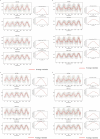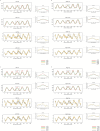Exploring the potential of the sit-to-stand test for self-assessment of physical condition in advanced knee osteoarthritis patients using computer vision
- PMID: 38384889
- PMCID: PMC10880867
- DOI: 10.3389/fpubh.2024.1348236
Exploring the potential of the sit-to-stand test for self-assessment of physical condition in advanced knee osteoarthritis patients using computer vision
Abstract
Introduction: Knee osteoarthritis (KOA) is a prevalent condition often associated with a decline in patients' physical function. Objective self-assessment of physical conditions poses challenges for many advanced KOA patients. To address this, we explored the potential of a computer vision method to facilitate home-based physical function self-assessments.
Methods: We developed and validated a simple at-home artificial intelligence approach to recognize joint stiffness levels and physical function in individuals with advanced KOA. One hundred and four knee osteoarthritis (KOA) patients were enrolled, and we employed the WOMAC score to evaluate their physical function and joint stiffness. Subsequently, patients independently recorded videos of five sit-to-stand tests in a home setting. Leveraging the AlphaPose and VideoPose algorithms, we extracted time-series data from these videos, capturing three-dimensional spatiotemporal information reflecting changes in key joint angles over time. To deepen our study, we conducted a quantitative analysis using the discrete wavelet transform (DWT), resulting in two wavelet coefficients: the approximation coefficients (cA) and the detail coefficients (cD).
Results: Our analysis specifically focused on four crucial joint angles: "the right hip," "right knee," "left hip," and "left knee." Qualitative analysis revealed distinctions in the time-series data related to functional limitations and stiffness among patients with varying levels of KOA. In quantitative analysis, we observed variations in the cA among advanced KOA patients with different levels of physical function and joint stiffness. Furthermore, there were no significant differences in the cD between advanced KOA patients, demonstrating different levels of physical function and joint stiffness. It suggests that the primary difference in overall movement patterns lies in the varying degrees of joint stiffness and physical function among advanced KOA patients.
Discussion: Our method, designed to be low-cost and user-friendly, effectively captures spatiotemporal information distinctions among advanced KOA patients with varying stiffness levels and functional limitations utilizing smartphones. This study provides compelling evidence for the potential of our approach in enabling self-assessment of physical condition in individuals with advanced knee osteoarthritis.
Keywords: body pose; computer vision; knee osteoarthritis; physical function; sit-to-stand; spatiotemporal information; stiffness.
Copyright © 2024 Zhao, Yang, Qin, Zhao, Zhao, Li and Liu.
Conflict of interest statement
The authors declare that the research was conducted in the absence of any commercial or financial relationships that could be construed as a potential conflict of interest.
Figures




Similar articles
-
Knee joint stiffness in individuals with and without knee osteoarthritis: a preliminary study.J Orthop Sports Phys Ther. 2006 Dec;36(12):935-41. doi: 10.2519/jospt.2006.2320. J Orthop Sports Phys Ther. 2006. PMID: 17193871
-
Biomechanics of the lower limb in patients with mild knee osteoarthritis during the sit-to-stand task.BMC Musculoskelet Disord. 2024 Apr 6;25(1):268. doi: 10.1186/s12891-024-07388-z. BMC Musculoskelet Disord. 2024. PMID: 38582828 Free PMC article.
-
The effect of transtheoretical model-lead intervention for knee osteoarthritis in older adults: a cluster randomized trial.Arthritis Res Ther. 2020 Jun 8;22(1):134. doi: 10.1186/s13075-020-02222-y. Arthritis Res Ther. 2020. PMID: 32513273 Free PMC article. Clinical Trial.
-
Effectiveness of Traditional Chinese Exercise for Symptoms of Knee Osteoarthritis: A Systematic Review and Meta-Analysis of Randomized Controlled Trials.Int J Environ Res Public Health. 2020 Oct 27;17(21):7873. doi: 10.3390/ijerph17217873. Int J Environ Res Public Health. 2020. PMID: 33121082 Free PMC article.
-
Global management of patients with knee osteoarthritis begins with quality of life assessment: a systematic review.BMC Musculoskelet Disord. 2019 Oct 27;20(1):493. doi: 10.1186/s12891-019-2895-3. BMC Musculoskelet Disord. 2019. PMID: 31656197 Free PMC article.
Cited by
-
Clinical trial of arthroscopic debridement combined with functional exercise in the treatment of advanced knee osteoarthritis: A retrospective observational study.J Back Musculoskelet Rehabil. 2024;37(6):1673-1683. doi: 10.3233/BMR-240106. J Back Musculoskelet Rehabil. 2024. PMID: 39213047 Free PMC article.
-
Feasibility of YOLOX computer model-based assessment of knee function compared with manual assessment for people with severe knee osteoarthritis.BMC Med Inform Decis Mak. 2025 Jan 24;25(1):40. doi: 10.1186/s12911-025-02877-0. BMC Med Inform Decis Mak. 2025. PMID: 39856682 Free PMC article.
References
-
- Sparkes V, Whatling GM, Biggs P, Khatib N, al-Amri M, Williams D, et al. . Comparison of gait, functional activities, and patient-reported outcome measures in patients with knee osteoarthritis and healthy adults using 3D motion analysis and activity monitoring: an exploratory case-control analysis. Orthop Res Rev. (2019) 11:129–40. doi: 10.2147/ORR.S199107 - DOI - PMC - PubMed
Publication types
MeSH terms
LinkOut - more resources
Full Text Sources

